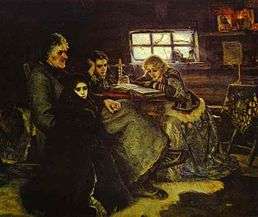Beryozovo, Khanty-Mansi Autonomous Okrug
Coordinates: 63°56′04″N 65°02′40″E / 63.93444°N 65.04444°E

Beryozovo (Russian: Берёзово) is an urban locality (an urban-type settlement) and the administrative center of Beryozovsky District of Khanty-Mansi Autonomous Okrug, Russia, located on the Ob River. Population: 7,287 (2010 Census);[1] 7,085 (2002 Census);[2] 7,573 (1989 Census).[3]
Geography
It is situated on three hills on the left bank of the Severnaya Sosva River, at its junction with the Ob River. It has more than once suffered from conflagrations, including fires in 1719 and 1808.[4] The yearly mean temperature is +4 °C (39 °F), with the low being −44 °C (−47 °F).
History
Some ill-documented Russian trade took place in the area before the Russian conquest of Siberia. Beryozovo was founded in 1593 on the Severnaya Sosva route across the Ural Mountains to the fur-rich Mangazeya region. Ostyaks besieged the settlement in 1592, 1697, and 1608. It grew into a town of Beryozov (Берёзов) in Tobolsk Governorate. By the late 17th century most trade had shifted south to Verkhoturye.
Prince Menshikov, the favorite of Peter the Great and of Catherine I, died here in exile in 1729. In 1730 Menshikov's enemy and rival, Alexey Grigoryevich Dolgorukov, was interned here with his family.
On 9 April 1740 the St. Petersburg-based French astronomer Joseph-Nicolas Delisle arrived in Beryozovo with the intention of observing the transit of Mercury due to take place on 22 April - but cloudy weather thwarted his plan. In his account of his expedition, Delisle mentions the name of the incumbent governor of Beryozovo: Fyodor Ivanov Schulginoff (Shulginov).[5] During his sojourn in Beryozovo, where he lodged in the house of the hetman of the Cossacks ("la maison la plus distinguée de la Ville"), Delisle visited the church founded by Menschikoff (Menshikov), where the prince was subsequently buried.[6] The town has a cathedral, near which lie buried Mary Menshikova (1711-1729, a daughter of Aleksandr Menshikov, who attempted to betroth her to tsar Peter II) and some of the Dolgorukovs.[4]

In 1742 the Empress Yelizaveta Petrovna banished General Ostermann to Beryozov with his wife; he died there in 1747.
In the mid-18th century, gold was discovered at Beryozovo — Siberia's first important gold mine. Serfs and convicts worked the mine under primitive conditions and produced about 400 ounces a year (by the mid-19th century the gold sands further east were producing 600,000 ounces per year). In the 1960s, gas fields were discovered near its lower course, causing major population growth in the area. Transport is by river boat or by ice road.
After 1825, Beryozovo became a place of exile for many of the Decembrists. In the 20th century, the Tsarist regime also banished a number of revolutionaries to the area.
In 1907, on his way to exile in Obdorsk, Trotsky escaped from Beryozovo on 12/13 February. It had taken him 33 days by train and horse to travel from St Petersburg. He mentions the exiling of Prince Menshikov.
Notes
- ↑ Russian Federal State Statistics Service (2011). "Всероссийская перепись населения 2010 года. Том 1" [2010 All-Russian Population Census, vol. 1]. Всероссийская перепись населения 2010 года (2010 All-Russia Population Census) (in Russian). Federal State Statistics Service. Retrieved June 29, 2012.
- ↑ Russian Federal State Statistics Service (May 21, 2004). "Численность населения России, субъектов Российской Федерации в составе федеральных округов, районов, городских поселений, сельских населённых пунктов – районных центров и сельских населённых пунктов с населением 3 тысячи и более человек" [Population of Russia, Its Federal Districts, Federal Subjects, Districts, Urban Localities, Rural Localities—Administrative Centers, and Rural Localities with Population of Over 3,000] (XLS). Всероссийская перепись населения 2002 года [All-Russia Population Census of 2002] (in Russian). Retrieved August 9, 2014.
- ↑ Demoscope Weekly (1989). "Всесоюзная перепись населения 1989 г. Численность наличного населения союзных и автономных республик, автономных областей и округов, краёв, областей, районов, городских поселений и сёл-райцентров" [All Union Population Census of 1989: Present Population of Union and Autonomous Republics, Autonomous Oblasts and Okrugs, Krais, Oblasts, Districts, Urban Settlements, and Villages Serving as District Administrative Centers]. Всесоюзная перепись населения 1989 года [All-Union Population Census of 1989] (in Russian). Институт демографии Национального исследовательского университета: Высшая школа экономики [Institute of Demography at the National Research University: Higher School of Economics]. Retrieved August 9, 2014.
- 1 2
 One or more of the preceding sentences incorporates text from a publication now in the public domain: Chisholm, Hugh, ed. (1911). "Berezov". Encyclopædia Britannica. 3 (11th ed.). Cambridge University Press. p. 771.
One or more of the preceding sentences incorporates text from a publication now in the public domain: Chisholm, Hugh, ed. (1911). "Berezov". Encyclopædia Britannica. 3 (11th ed.). Cambridge University Press. p. 771. - ↑ Continuation de l'Histoire Générale des Voyages, ou Collection Nouvelle, 1°. des Relations des voyages par mer, découvertes, observations, descriptions, Omises dans celle de feu M. l'Abbé Prevost, ou publiées depuis cet Ouvrage, 2°. des Voyages par terre faits dans toutes les parties du monde, contenant Ce qu'il y a de plus remarquable, de plus utile & de mieux avéré dans les Pays où les Voyageurs ont pénétré; avec les Mœurs des Habitans, la Religion, les Usages, Arts, Sciences, Commerce, Manufactures, &c., vol. 72, Paris: Chez Rozet, 1768, p. 114.
- ↑ "l'Eglise qu'a fait bâtir le fameux Prince Menschikoff, qui y est inhumé sous l'autel", Continuation de l'Histoire générale des voyages, vol. 72, Paris, 1768, p. 116.
External links
- Beryozovo Museum (mostly in Russian with some English)